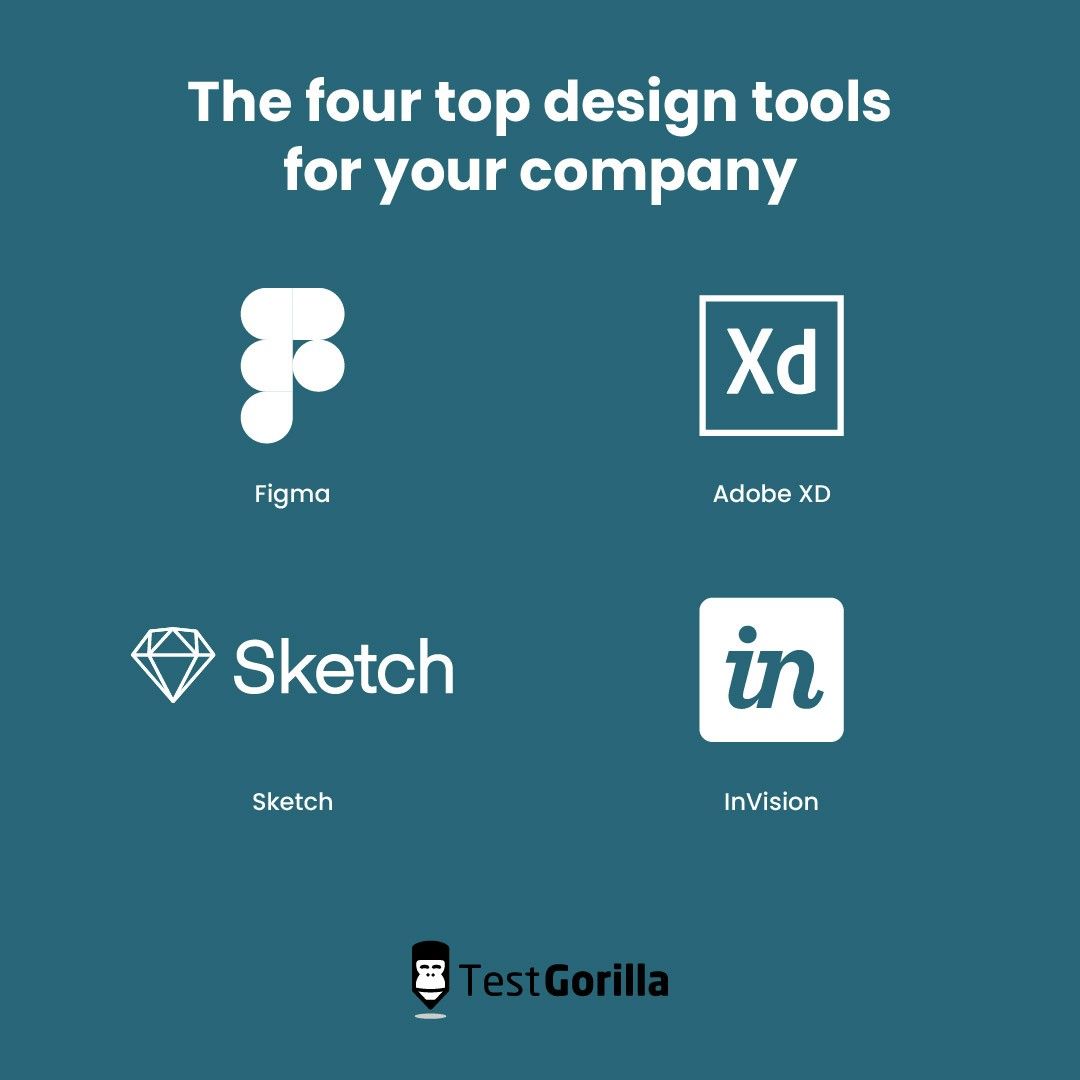If your company develops software products, offering a great user experience should be your main goal. Therefore, you must put in extra effort to ensure that your clients leave only good reviews about your business and its products.
Multiple UI/UX design tools can help you boost user experience. However, four of the most popular and most effective tools are Figma, Adobe XD, Sketch, and InVision, each of which is known for its perks and advantages.
As a recruiter, it’s crucial to pick the perfect platform that suits your organization before you start hiring designers. However, this choice can be difficult since all four tools have similar aspects.
So how do you know which one is right for your company?
In this article, we will answer that question by exploring and comparing these four design tools and discussing what makes each one unique. We’ve also included a tip on identifying skilled UI/UX designers who can efficiently navigate whichever design platform you choose.
Table of contents
The four top design tools for your company
Of the many design tools in the world today, four stand out as the most popular and versatile. Figma, Sketch, InVision, and Adobe XD are known for their powerful features that help businesses create beautiful user experiences.
Although they seem similar at first, each tool has its own pros and cons. Let’s go into detail about each one of them and their various features:
1. Figma
Figma is a cloud-based UI/UX design tool that functions as a graphic and web design platform. It was released in 2016, and since then, it has become UI designers’ favorite choice for creating and designing web applications.
Aside from UI/UX design, Figma is also used for prototyping, graphic design, wireframing, and collaboration. It works directly on a browser as well, making it more accessible. Additionally, Figma offers templates to make designing easier and less time consuming.
2. Adobe XD
Adobe XD is a design tool launched by Adobe in 2016. Although the platform isn’t free, it offers many features that ease the process of designing user experiences.
With just one click, you can easily create new projects or prototypes. Despite being an independent platform, Adobe XD also integrates with other sites to obtain resources.
3. Sketch
Sketch is a desktop design tool for macOS with a robust user interface. Designers choose Sketch because it is frequently updated and can be enhanced with various plugins to make designing easier and faster.
The Sketch platform also has collaborative features that enable designers to share ideas and work together to boost their productivity.
4. InVision
InVision is a design and prototyping tool that helps designers create and share their designs. It offers high-quality design presentations and enables designers to communicate with clients easily.
Although it is relatively new software, InVision has become a widely adopted platform for creating advanced animations.
Which tool should you select for your business?
Though Figma, Adobe XD, Sketch, and InVision are all excellent design tools, they each have strengths and weaknesses. So to easily identify the right design tool for your company, you must measure them according to certain standards.
Below, we’ll compare Figma, Adobe XD, Sketch, and InVision based on their cost-effectiveness, collaborative features, supported platforms, handoff properties, and offline availability, all of which are critical factors when choosing a design tool.
Cost-effectiveness
Your budget is a major factor to consider before choosing a design tool for your organization. Effective budget management helps you obtain quality services without drastically adjusting your original plans.
Figma offers a free plan for individuals. However, to activate team functionality, you’ll need to subscribe to the premium plan, which comes with unlimited projects and full-time collaboration.
Adobe XD currently only offers paid subscriptions starting at $9.00 monthly.
Sketch offers a $9.00 per editor monthly subscription and a $99.00 per editor yearly subscription that gives you access to all the platform’s features.
InVision is currently free for individuals and small teams. However, it offers subscriptions that vary in terms of team sizes and services rendered.
Collaborative features
The main reason why collaboration is such an important feature of any design tool is that designers work better in teams. Excellent teamwork brings together designers with problem-solving skills who can share ideas and propose viable solutions.
Figma is considered the most reliable design tool in this area. The platform was built for designers to share their designs and get feedback from their teammates.
Adobe XD supports co-editing.
Sketch doesn’t support collaboration natively but uses plugins for collaboration.
InVision currently doesn’t support live collaboration, but it is possible to generate links to share projects.
Supported platforms
The more platforms a UI/UX design tool supports, the more flexible it is. Hence, for a design tool to be effective, it must support various platforms.
Figma is a browser-based tool, which means that as long as designers have internet access, they’ll have no issue using it. It runs on Windows, Chrome, Linux, and Mac operating systems.
Adobe XD only supports Mac and Windows operating systems.
Sketch supports only Mac operating systems, which limits developers from accessing some design files.
InVision supports Mac and Windows.
Handoff properties
After designers finish working on a project, they hand it off to developers to implement it in code. As such, design tools with good handoff features make these project transfers easier.
Since Figma is a collaborative tool, developers can easily access the designs regardless of their operating system.
Adobe XD enables designers to export their projects and share them with developers with a single link.
Sketch recently launched its handoff feature “Cloud Inspector.” It also has an alternative plugin called “Sketch Measure,” which is useful for exporting design files.
InVision uses a third-party website called “Inspect now” for handoffs.
Offline availability
Offline availability is a feature that gives designers an opportunity to work offline without risking losing their designs. This feature is important because it enables designers to access their designs anytime, making it easier for them to complete their work.
Figma doesn’t support offline availability because it is a cloud-based platform and requires an internet connection for full functionality. However, Adobe XD, Sketch, and InVision are available offline.
Essentially, the best choice depends on what you value most. If you’re searching for a UI/UX design tool with top-notch prototyping features, Adobe XD is the ideal option. However, if you want a design tool with multiple plugins, it may be better to use Sketch.
Unlike Figma, InVision requires designers to switch between various tools, which gives it fewer collaborative advantages. On the other hand, Figma is perfect for live collaboration, project management, and teamwork.
Finding the right designer for your company is easy with TestGorilla
Once you’ve chosen the UI/UX design platform that suits your organization, the next step is hiring a designer to operate the platform. Sorting through applications is time-consuming, especially if you’re trying to review hundreds of CVs to find the few candidates who are qualified for the post.
Thankfully, TestGorilla has a library of pre-employment tests, which are a more reliable alternative to CVs. With pre-employment tests like our Figma test, you can assess each candidate for the essential skills they need to operate the design tool you’ve selected.
So, whether you’re hiring a Figma developer or an Adobe specialist, TestGorilla has the perfect skills test for you.
Create a free account with us today and start enjoying efficient recruitment.
Related posts
Hire the best candidates with TestGorilla
Create pre-employment assessments in minutes to screen candidates, save time, and hire the best talent.
Latest posts
The best advice in pre-employment testing, in your inbox.
No spam. Unsubscribe at any time.

Hire the best. No bias. No stress.
Our screening tests identify the best candidates and make your hiring decisions faster, easier, and bias-free.
Free resources
This checklist covers key features you should look for when choosing a skills testing platform
This resource will help you develop an onboarding checklist for new hires.
How to assess your candidates' attention to detail.
Learn how to get human resources certified through HRCI or SHRM.
Learn how you can improve the level of talent at your company.
Learn how CapitalT reduced hiring bias with online skills assessments.
Learn how to make the resume process more efficient and more effective.
Improve your hiring strategy with these 7 critical recruitment metrics.
Learn how Sukhi decreased time spent reviewing resumes by 83%!
Hire more efficiently with these hacks that 99% of recruiters aren't using.
Make a business case for diversity and inclusion initiatives with this data.





















